Pronounce as ae.bahlow'niy as in aborigine is well known as one of the 8 treasure of Dried Seafood in Chinese cuisine. The common name, abalone, is probably from the Spanish term aulon or aulone.
The 8 treasure includes – Dried Abalone, Dried Scallop, Dried Fish Maw, Dried Sea Cucumber, Dried Shark’s Fin, Dried Fish Lips , Dried Oyster and Dried oops! I don’t remember whats the last product but do believe it to be Dried Fish – sole,etc.
From ancient days to now, it is very costly and valuable, we cant afford to eat them daily. Can you ? A normal quality canned abalone cost RM100.00 average. Calculate yourself to see whether you can afford them daily, weekly, monthly or whatever……
Abalone is classified as any of various large edible marine gastropods of the genus Haliotis having an ear-shaped shell with pearly interior. Believe it or not, they are SNAILS ! They are found from the intertidal to the depth limit of marine plants (approximately 80-100 m), from tropical to cold waters
Abalone, like shark’s fin, is a symbol of wealth and good fortune to the Chinese and is considered a banquet fare. Abalone is used to impart a distinct flavor to Chinese soups; its succulent taste and velvety texture are enticing. One of the finest and most expensive ingredients used in Chinese cuisine, this large marine snail is called “Pao Yu” in Chinese, known as "awabi" in Japanese cuisine, as "loco" in South American, as "ormer" in the English Channel, as "muttonfish" in Australia and as "paua" in New Zealand. Abalone are found in the water where rocks and seaweed are abundant. There are a few varieties available and the red abalone is the largest of the species and most generally available.
Abalone shells are unique snail shells, having a single, flat shell with a wide opening for the body and a single row of holes along one side of the shell(the left side). The holes normally ranging from 9 – 14 holes, continue to be formed throughout the life of the abalone. As they grow, new holes are made and older holes are filled in. These holes are used in the respiration, sanitation, and reproduction of the abalone. The typical spiral part of the snail shell is reduced and very flat in the abalone (called the apex). It may even be hard to notice this spiral in older animals who may have other organisms growing on the shell or have had a lot of abrasion in this area.
Shells are prized because of their inner, iridescent layer. The muscular foot has strong suction power permitting the abalone to clamp tightly to rocky surfaces. A column of shell muscle attaches the body to its shell The mantle circles the foot as does the epipodium, a sensory structure and extension of the foot which bears tentacles. The epipodium projects beyond the shell edge in the living animal. The epipodium surface may be smooth or pebbly in appearance and its edge may be-frilly or scalloped. It is the most reliable structure for identifying abalone species.The internal organs are arranged around the foot and under the shell. The most conspicuous organ, the crescent-shaped gonad, is grey or green in females and cream colored in males. It extends around the side opposite the pores and to the rear of the abalone. The abalone head has a pair of eyes, a mouth and an enlarged pair of tentacles. Inside the mouth is a long, file-like tongue called the radula, which scrapes algae matter to a size that can be ingested.The gill chamber is next to the mouth and under the respiratory pores. Water is drawn in under the edge of the shell, and then flows over the gills and out the pores. Waste and reproductive products are carried out in this flow of water.Since it has no obvious brain structure, the abalone is considered to be a primitive animal. However, it does have a heart on its left side and blood flows through the arteries, sinuses and veins, assisted by the surrounding tissues and muscles.
Click here for a view of abalone anatomy without shell.
For more info please refer to here
Species
In the animal kingdom, abalone belong to the phylum Mollusca, a group which includes clams, scallops, sea slugs, octopuses, and squids. Molluscs are worldwide and predominantly marine. They have a soft body surrounded by a mantle, an anterior head, and a large, muscular foot. Molluscs are best known for their beautifully formed and colored calcareous shell secreted by the mantle.
The abalone join other snails, whelks, and sea slugs in the class Gastropoda. Members of this class have one shell, as opposed to clams with two, or the shell may be lacking altogether, as in the sea slugs, move by means of a broad muscular foot. The spiral structure, so common in snail shells, is flattened in the abalone and may be obscured by fouling and shell boring organisms.
Abalone are members of the family Haliotidae and the genus Haliotis, which means sea ear, referring to the flattened shape of the shell.
Natural History
Abalones reach sexual maturity at a small size, and fertility is high and increases exponentially with size. Sexes are separate and fertilization is external. The eggs and sperm broadcast into the water through the pores with the respiratory current. A 1 ½ inch abalone may spawn 10,000 eggs or more at a time, while an 8 inch abalone may spawn 11 million or more eggs. The spawning season varies among species with black, green and pink abalone spawning between spring and fall, and pinto abalone spawning during the summer. Red abalone in some locations spawn throughout the year. The fertilized eggs hatch into floating larvae that feed on plankton until their shells begin to form. Once the shell forms, the juvenile abalone sinks to the bottom where it clings to rocks and crevices with its single powerful foot. Settling rates appear to be variable. After settling, abalones change their diet and feed on macroalgae.
Juvenile abalones feed on rock-encrusting coralline algae and on diatom and bacterial films. Adult abalones feed primarily on loose pieces of marine algae drifting with the surge or current. Large brown algae such as giant kelp, bull kelp, feather boa kelp and elk kelp are preferred, although other species of algae may be eaten at various times.
Abalone eggs and larvae are consumed by filter-feeding fish and shellfish. Predators of juvenile abalones include crabs, lobsters, gastropods, octopuses, seastars, and fishes.
Reproduction
The sexes are separate and can be distinguished in individuals as small as one inch when the gonads begin to develop. The eggs or sperm are released through the pores with the respiratory current. This is known as broadcast spawning. A 1.5 inch abalone may spawn 10,000 eggs or more at a time, while an 8 inch abalone may spawn 11 million or more. Spawning may be controlled by the water temperature or length of the day. The presence of eggs and sperm in the water may stimulate other abalone to spawn, thus increasing the chances of fertilization
Source from AbaloneDotNet. Do visit for info on abalone life cycle. Then you will understand why Abalone are so expensive.
History
Abalones have lived along the coast worldwide for millions of years. Fossilized shells closely resembling modern abalone have been found in sediments approximately 100 million years old. In more recent times abalone were important in the economy of all native peoples who dwelled in coastal areas.
Reference from some Chinese book
Abalone used to be called “Fu Yu” literary Stomach fish as it moves on its stomach ( actually the muscular foot)
During the Ming and Ching Dynasty, it is already in the list of the 8 treasure as per text found by historian. A Han Emperor by the name of “Wang Mang” loves this dish so much that he must have it daily. This was during his reign from 9 –23 AD.
220 – 280AD , cant remember which Dynasty, a powerful General by the name of “Cao Chao” love it as well. To please him, most rich man those days would present this dish in their Banquet.
Until the South Sung Dynasty 1127 – 1129 AD a scholar name “Su Tong Po” from where the dish called “Tung Po Yok” came from, wrote a poem called “Fu Yu Sing”. The way he describe the abalone had turned abalone to a MUST HAVE luxury item in their menu.
The abalone dish for the present time, was created by a famous General Tham from the famous THAM FAMILY CUISINE – “Tham Kar Choy”. This abalone dish called “Hong Siu Pau Yu” and “ Hou Yau Pau Yu” became a must to master for all Chinese Chef. This was during the early communist reign from 1911 – 1949 in Peking now known as Beijing.
In Chinese term of nutritional value, abalone have “Chi Pou” where it is considered as a food that will increase your body strength as in tonic. It is also known for its “Meng Mok” literary for good eye sight, “Moon Yi Luk” increasing our natural antibody.
Abalone is good for the ladies as they are also known for “ Chi Yam” literary meaning maintaining and assisting in balancing the hormone. Ahem ! So, all the hubby, feed your wife with abalone and it you get to enjoy your sex life more. Chuckle ! Just kidding, okay ?
Besides that, they are also “Cheng Yit” – rid the body of excess heat and “Yong Ngan” – for beauty of skin. Man, I don’t even know some of the word they uses to describe the goodness of abalone. My chef need to explain it to me several time to this BANANA before I can even grasp what he is trying to say.
In Chinese, abalone is also call
Ching Mian Yu– Mirror Fish
Jiu Kong Luo – 9 hole Snail
Meng Mok Yu – Eye Sight Fish
And lastly Hai Er as in Sea Ear due to the shape of the shell which is like a flatten ear.
Besides sweet and succulent of the foot, the abalone SHELL can be use to cure some eye disease especially improving eye sight. The Shell is call “Shi Jiu Ming” meaning bright eye as they believe once you consume the shell ( believe it to be in powder form) your eye sight will be improved. This is a part of the Chinese medicine.
Just like most exotic ingredients used in Chinese cuisine, the abalone is valued for its numerous medicinal properties. It’s high in protein, vitamin E, selenium and magnesium. Besides being reputed to be an aphrodisiac, the abalone is said to be good to our eyes and immune system. However, abalone should be avoided by people having a fever, flu or sore throat.
Commercial Abalone
The present commercial fishery began in the mid-nineteenth century, and peaked at an annual harvest of over five million pounds in 1957. Thereafter, about four million pounds were harvested annually until 1969 when a serious decline began. The decline has continued and in some places the fishery has disappeared altogether
Abalone are normally sold fresh as in live, frozen or chilled, dried and canned.
Yearly production is about 12,000 metric tonnes throughout the world. As in most food, with different environment we will get different quality.
Strong wave will effect the texture and maturing time. Different water temperature will effect and in some cases will decide the flavour and taste of the abalone.
Ideal condition for abalone
Abalone require water of the same chemical composition as seawater.
Fast water flow – intertidal zone or subtidal zone
High Salt content – no mixture of fresh water. That’s why we cant find abalone near river mouth.
Depth - No more than 400 metre. Different species different depth. For example, red abalone of California normally thrive in water depth of about 6 meter.
Reef – it is important to have reef as the seed or baby abalone needs to hide from predator. It takes them 3 – 4 years to grow up to 110 – 130 mm and that’s the SHELL diameter. A long time., eh ?
There are more than 100 species of abalone and most comes or grow naturally (as in wild) in Australia, Japan, New Zealand, Africa, China, Mexico, some Europe country, US, Canada and Middle East.
The easiest to categorize them is via their shell colour. Red abalone have a reddish shell with red margin. Pink is pinkish white with pink margin.
Click here for some example of North American 8 species of abalone.
They are normally divided by their colour after cleaning. These are basically divided into 4 groups
1 Green Lipped Abalone - :Cheng Pin Pao ( Cantonese ), Qing Pian Pao ( Mandarin )
Most are found in Japan, Australia and Europe. Yearly average production topped 600metric tonne. These abalone are easily identified by the green colouring on the lips or foot of the abalone. They are mostly sold as frozen or canned product. It is tender and have a distinct abalone flavour. Cant describeit correctly in English. In Cantonese, it is described as “Long Nyuok”.
2 Black Lipped Abalone – “Hark Pin Pao” “Hei Pian Pao”
Mostly found in Africa, Australi and Mexico. Yearly production topped 4,200 metric tonne. Sold as live, chilled or canned product. Character similar to Green Lipped abalone except for the colour.
3 Brown Lipped – “Chong Pin Pao” “ Zhong Pian Pao”
Africa, Japan and Mexico is the main producer. This abalone is the most expensive and it topped 100 metric tones yearly .Usually bigger in size as in 1 head, 2 head and up to 4 head maximum in size. The colour is similar to the dried abalone – coffee colour It is very flavourful.
4 Mexico Abalone – “Mak Xai Co Pao” usual brand – Alisan and Wheel Brand
No need to mention where . It is usually canned. Mexico was one of the first and biggest canned abalone producer in the world. Topping 5,000 metric tonnes per annum. However, due to over fishing as they called it and environment pollution, they are now only producing 400 metric tonnes yearly. Taken over by Australia.
some picture here
Basic Processes
Sun Dried whole abalone.
Remove shell
Soaked in Brine
Blanch with hot water
Toast over charcoal
Sun Dried Again
The whole process takes about 2 – 4 weeks depending on sizes and method of drying. The process is very delicate and it takes years to master. The most important factor is the flavour, what the Cantonese called “Thong Sam” – Sugar Heart that really means the natural sweetness that accumulates in the muscle part as they dried. The texture can be described as similar to “Nian Kao” – It is smooth, kind of sticky when sliced ( like natural glue from gluten), the aroma is great and it will have a very strong abalone flavour. Chuckle ! Whatever ………
Dried abalone is normally divided in 6 groups
1Aomori – This abalone is one of the most famous and expensive of all dried abalone. As the name implied, its from a prefecture in Japan. This process is specialized by a Master Abalone Chef. I don’t know the Japanese name. It’s a family secret and will not passed to outsider. He is one of the 3 Master Abalone in the world. This abalone is considered by most to be the BEST quality dried abalone. Usually 1, 2, or 4 head abalone. Uses Brown Lipped Abalone.
It is similar to olive in shape but rounder. It had small lips and a lot of pearly like frills that is even. Near to white coffee in colour. As it is a very sensitive process, they only uses good quality fresh abalone. However, due to pollution and weather changes, the quality of this product had deteriorated.
Aomori is called “Mong Pao” in Cantonese as when it is slice horizontally, there is a net like lining on the muscle of the flesh.
Australia produces similar dried abalone but the pearly like frills are uneven in sizes. The texure is also tougher and have a woody sort of flavour. Africa’s will be much saltier.
2 Oma – Also known as “Her Ma Pao” or “Woma Pao”. From Japan , specialize by another family of Master Abalone Chef lead by Master Chef “Yong Kok” or “Xiong Gu” in Chinese. No known Japanese name.
This abalone is smaller in size as compared to Aomori. Biggest produced was 8 head abalone. It is also flatter – not as thick in the middle of the abalone muscle that we so love.
This abalone is known visually from a hole in the middle of the abalone. This is caused by the rope used to link the abalone for drying. The lips usually have a small scar caused by hook used to hook up the abalone. Uses smaller species of brown abalone that usually lives in the crevices of reef.
Since it is much smaller in size and thus cheaper, rich people usually take this abalone as snacks. What a waste. It is very tender and can be easily digest even by the elderly.
3 Iwate – also called “Kat Pan Pao” or “Ji PinPao” specialized by Master Chef “Ping Tian Wu Lang” in Chinese. The shape is similar to “Yin Pou” – err……Remember those Chinese movie that uses a junk like piece of Silver or Gold as $$ ? That is the shape that I wanted to explain. Get it ?
After drying, it will appear to be shiny. The texture is al dente and the flavour is hehehehhehe, flavourful. “Long Nyuok”. Visually you will see a line across the abalone caused by rope tying the abalone for drying. The tied the abalone on both end and leaving some bikini string like marking on the abalone. Iwate abalone have a high lips and it looks swollen. A good quality abalone that we usually get from a high class Chinese Restaurant.
It is located on the South of Aomori Prefecture.
4 Next on line will be the Middle Eastern Abalone.
Abalone from here is as not as good as those from Japan. Similar process but due to lack of experience and technique, the dried abalone have a tougher body in texture. You will have to braised them longer and the flavour is not as good too. However, the flavour can be improved with the addition of dried scallop to enhance the stock used for braising. Over the years they had improved their technique and have a quite reputable dried abalone in appearance
5 Solo ( Philippines ), Korean and Vietnamese Abalone
Usually sold as fresh or frozen. This abalone are not as good in quality due to water condition. If dried, Chef’s would normally used them as additional flavour for soup. The cheapest of the 3 will be Solo Abalone.
6 Last but not least is the China’s Da Lian Pao
Either sold as live or frozen . Their drying process skills is far beyond the rest of the world. Most of the times, you will get abalone that are only dried 60 – 70% only. This will cause a problem during storing. You will get fungus growing on your abalone and that will cause food poisoning, if consumed. They also smell of chemical. Easily recognize by the amount of salt crystal on the body of the dried abalone. They are similar to those from Vietnam but quality slightly better, if sold fresh or frozen.
The top 3 abalone, namely Aomori, Oma and Iwate is expensive because
- They are processed by Master Chef – quality guaranteed
- Longer growing and maturing time, averaging 10 – 20 years depending on size.
- Producing area – Japan where almost everything is expensive.
Example that my Chef had given me was this. For Aomori abalone….usually not more than 4 head in sizes. The sizes are indicated as such – after drying, they will weigh the abalone. They will calculate the numbers of abalone to a catty – 600 gm. If it is one number to a catty then it is called 1 head. That means that 1 number of abalone must be 600 gm – dried. Imagine how big it was when it was fresh. Imagine how many years it takes to grow to that size ? The more numbers you have in a catty, the smaller the sixe of the abalone. A 24 head abalone after cooking is only about 1 ½ - 2 inches in length.
Thus for Aomori abalone – it will be dried and process and reduced to 5 times the fresh abalone size before they will sell. So, if your abalone is a 2 head abalone ( 2 numbers in a catty ) the actual weigh of the abalone will at least 1.5kg including the shell. Can you I imagine that ? No wonder it is that EXPENSIVE. How can we commoners afford to eat that ? do you want to pay RM6,000.00 for a piece of Aomori Abalone ? Even if you can afford, it would be difficult to find a Restaurant that have this kind of abalone.
There is a saying in Chinese “ No wonder, if you eat abalone in a bite, it is expensive ” – literary it means take your time to savour the flavour of this luxurious delicacy.
Pricing
For the last 10 – 20 years, dried abalone price had increased by about 200 – 300%. Due to the scarcity, it is getting more expensive and it is difficult for us to even find those about 12 head. Forget about the bigger in size.
In Chinese cuisine, abalone had taken over shark’s fin in becoming the Emperor of Luxury Delicacy , in terms of pricing.
Choosing and cooking in brief
Abalone can be purchased fresh, canned, dried or salted and is available in markets and Asian specialty stores. The best kind of dried abalone is devoid of cracks and mold. Avoid darkened ones. If purchased fresh, it should be alive and not fishy-smelling. Refrigerate fresh abalone as soon as possible in the coldest part of the refrigerator and cook within a day of purchase. Store frozen abalone in its wrapper in the freezer and it will last for two months. Canned abalone is the most popular for home cooking because it’s cheaper and easier to prepare.
Fresh abalone is usually briefly sautéed or fried and must be tenderized by pounding before cooking. If you manage to procure processed abalone steaks, they will already be tenderized. Fresh abalone should be fried not more than 30 seconds per side or it will become tough and chewy. Dried abalone, on the other hand, is ideal for soups because it has a more concentrated flavor than that of a fresh one. It is usually simmered in broth for many hours to soften it and served whole or in slices with savory topping sauce. The time to simmer depends on the size of the abalone. It is very important that abalone is not overcooked or they will become chewy.
Source and Reference
marine science
abalonedotnet
seafood@ucdavis
biosbcc
vetigastropoda
sonicdotnet
Korean
japanshop
Mbayaqdotorg
zeridotorg
seafood@ucdavis
zoology
seasabresdotcom
oceanlinkdotnet
Sorry I cant provide picture for the time being....maybe I will have them for my next post. Hang on
Disclaimer - The above is quoted from internet sources and books. It does not represent that the reviewer is an expert in this field. He is merely, doing his research for his own knowledge and information.
Cheers !
South African Dried Abalone
A friend of mine got this abalone F.O.C. from his friend in South Africa. Apparently, it is cheap there...not sure as i have yet to venture into that part of the world.
While still researching about abalone and awaiting for picture to be uploaded to me, i just post this for fun.....lolz

A 3 inches dried abalone - about 24 head abalone. Head = nos of abalone in a catty ( 600 gm ). If you have 2 numbers of abalone weighing 600gm then they are called 2 head abalone. If you have 24 pieces in a catty then they are 24 head. Usually they are in even numbers...
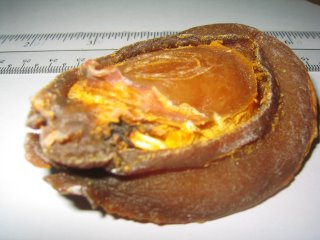
Side view of the snails - family species....
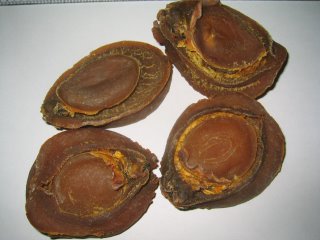
4 different sizes and shape. They are not as expensive as those from Japan or Australia.
Cheers!
While still researching about abalone and awaiting for picture to be uploaded to me, i just post this for fun.....lolz

A 3 inches dried abalone - about 24 head abalone. Head = nos of abalone in a catty ( 600 gm ). If you have 2 numbers of abalone weighing 600gm then they are called 2 head abalone. If you have 24 pieces in a catty then they are 24 head. Usually they are in even numbers...

Side view of the snails - family species....

4 different sizes and shape. They are not as expensive as those from Japan or Australia.
Cheers!
FooDcrazEE eats - Kampar Stuffed Bread
As mentioned in my earlier post, I passed by this shop or restaurant called Yau Kee Restaurant a branch of the main restaurant from Kampar, Ipoh located in the district of Kinta Selatan. Heard about this restaurant and believe it or not, this is the first time, I tasted their product. Not sure when they sort of created them for commercial but it's quite sometime ago, I guess. Search the net and i got this story Not bad, eh ?
Robyn of EatingAsia had posted them recently with his Kampar version just lately. Mine is from Ipoh the branch. From his picture, it does look different. The bread texture, etc. They have 2 version, Curry Chicken or Herbal Chicken. I opted for the Herbal as I have sort of tasted the Curry Chicken from somewhere, cant remember when it was or where.
What they does is precooked the chicken and then wrapped them in a parcel of grease proof paper and load them in bread dough. Eh ? WTF, I meant, they put the chicken parcel into bread dough and then baked the bread till cooked.
I dont know about you guys but it does not really taste that great. The herbal concoction doesnt leave much flavour to the starchy sauce and the chicken was pre fried. I was thinking more of a non fried chicken with a nice herbally flaovoured sauce base. The bread itself is nothing fancy, just basic bread but i believe they place quite a generous amount of margarine and maybe even some lard to make them looks real good. It is very yellowish in colour but the texture is kinda bland.
It cost us RM22 , i think or is it RM24 for this what they called SMALL portion. Cant remember the price, must be getting old - chuckle
On your next trip up north, maybe you guys can try and then feed back to us.
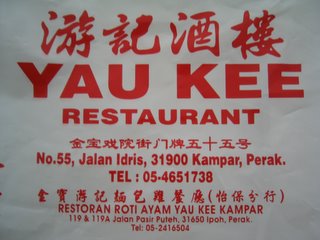
The plastic bag with their company's info.

The box holding the whole dish and the actual product doesnt look anything like the image on the box. Can we sue them ? chuckle!
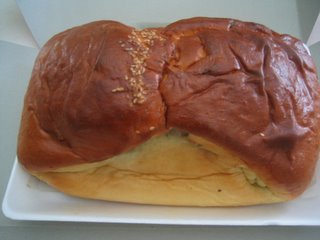
This picture was taken with my mobile phone camera using natural light. Not very appetizing, is it ?
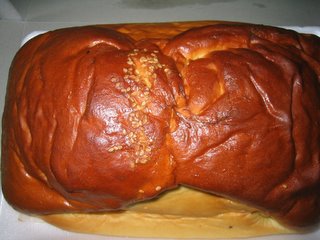
Using my old IXY 3.2 ( yeah, I got the camera when my BIL was in Japan 4 - 5 years ago. Still using it. Cant afford a new one $$ lolz )

Another image from the camera.

The bos even came with instruction on how to serve the dish.

Remove the chicken from the bread to reheat as it was 3 hrs after we bought them back.

Follow the instruction but it doesnt work. So, peeled them off with our bare hand - after washing of course . Sanitation and hygiene.......chuckle. Compare this picture with Robyn's and you will notice that Robyn's version is kinda rough but this is more fluffy - is it because of the margarine ??

After reheating, the paper is kinda thick and difficult even to cut them up. Tear them instead. The sauce over flows as I under estimated the amount. Somehow the herbs doesnt penetrate the chicken and that left it quite bland.
Disclaimer: The opinions expressed here is entirely based on my personal experience and taste. It may vary for others. This review is done solely for personal blog and by no means the reviewer receive any monetary or non monetary compensation.
Cheers !
Robyn of EatingAsia had posted them recently with his Kampar version just lately. Mine is from Ipoh the branch. From his picture, it does look different. The bread texture, etc. They have 2 version, Curry Chicken or Herbal Chicken. I opted for the Herbal as I have sort of tasted the Curry Chicken from somewhere, cant remember when it was or where.
What they does is precooked the chicken and then wrapped them in a parcel of grease proof paper and load them in bread dough. Eh ? WTF, I meant, they put the chicken parcel into bread dough and then baked the bread till cooked.
I dont know about you guys but it does not really taste that great. The herbal concoction doesnt leave much flavour to the starchy sauce and the chicken was pre fried. I was thinking more of a non fried chicken with a nice herbally flaovoured sauce base. The bread itself is nothing fancy, just basic bread but i believe they place quite a generous amount of margarine and maybe even some lard to make them looks real good. It is very yellowish in colour but the texture is kinda bland.
It cost us RM22 , i think or is it RM24 for this what they called SMALL portion. Cant remember the price, must be getting old - chuckle
On your next trip up north, maybe you guys can try and then feed back to us.

The plastic bag with their company's info.

The box holding the whole dish and the actual product doesnt look anything like the image on the box. Can we sue them ? chuckle!

This picture was taken with my mobile phone camera using natural light. Not very appetizing, is it ?

Using my old IXY 3.2 ( yeah, I got the camera when my BIL was in Japan 4 - 5 years ago. Still using it. Cant afford a new one $$ lolz )

Another image from the camera.

The bos even came with instruction on how to serve the dish.

Remove the chicken from the bread to reheat as it was 3 hrs after we bought them back.

Follow the instruction but it doesnt work. So, peeled them off with our bare hand - after washing of course . Sanitation and hygiene.......chuckle. Compare this picture with Robyn's and you will notice that Robyn's version is kinda rough but this is more fluffy - is it because of the margarine ??

After reheating, the paper is kinda thick and difficult even to cut them up. Tear them instead. The sauce over flows as I under estimated the amount. Somehow the herbs doesnt penetrate the chicken and that left it quite bland.
Disclaimer: The opinions expressed here is entirely based on my personal experience and taste. It may vary for others. This review is done solely for personal blog and by no means the reviewer receive any monetary or non monetary compensation.
Cheers !
FooDcrazEE eats - Ipoh Pomelo
Returning from Penang, decided to drop by Ipoh since my MIL wanted to visit the temple there. Got off the wrong inter change at Jelapang. Have to travel further in before we reach the Sam Po Tong the Lime Stone Caves Temple. On the way, we pass by a shop called Yau Kee Restaurant and remembered it was supposed to be a restaurant selling the famous Chicken Bread from Kampar. Thats for another post.
After the visit and since we all know that Ipoh have what we called Hard water since they are sitting on top of a large karst formation, the food here is different from anywhere else in Malaysia. Of course, Ipoh is famous for their Hor Fun that we called Ipoh Sar Hor Fun. We had that for lunch and being too hungry, I have forgotten to snap a picture or two for the 2 dish - Ipoh Hor Fun Soup and Herbal Beef Hor Fun. This 2 dishes are so delish and the pircing is fair - RM3.00 for the hor fun and RM3.50 for the beef.
Then we stop by the road side where all the pomelo's are sold. Looking at the nearest stall, we saw 2 leggy beauty and that reminds me of Taiwan's
檳榔西施 , Betel Nut Beauty or Girls. That turns me off and i opted to shop from an old looking couple. Looks like they had been around and they should know more about pomelo than these 2 so called beauty - chuckle.
Ipoh is considered the Pomelo Centre of Malaysia and they are known as Ipoh Tambun Pomelo. An article came out earlier in a chinese newspaper, cant remember which as i dont read them. Wife told me, its due to the water and soil in Ipoh that create a better taste pomelo. They dont have the after zesty taste that you get with other pomelos. Even the sacs dont leave as much fibre ?? as compared to the rest.
I know nuts about choosing this fruit and so, MIL went and chose. She bargain with them and for 2 numbers, it only cost us RM18.00. Actual price - Large size = RM12.00, small at RM 10.00. Well, to me its already cheap and wouldnt have bargain with them.

This is the bigger size pomelo

Different of sizes and species

The peel of pomelo - Remember when we used to wear this and play with them. That used to be my soldier helmet since it is green.
We used to sun dried them up and then use for cooking. It lends a fragrant into our dessert especially the "Tong Sui" - Sweetened Broth Dessert

The peeled pomelo. Notice the top of the fruit. We got a bonus of a baby pomelo forming in it. Kinda sweet. chuckle


The bigger of the two with reddish sac. It is so damn sweet that we finish the whole fruit that night itself. I took in about 2/5 of the fruit. Couldnt resist.....

The vendor asked if the pomelo was to be kept of eaten immediately. The red one was to be eaten within the day and the smaller can be kept up to 3 more days. So, 2 days later, we peel them again and hmm......not as good as the red one but still delish !

Now, i'm out of pomelo and thinking I better asked my friend to get me one when she's back to Ipoh on her next day off.
Cheers !
After the visit and since we all know that Ipoh have what we called Hard water since they are sitting on top of a large karst formation, the food here is different from anywhere else in Malaysia. Of course, Ipoh is famous for their Hor Fun that we called Ipoh Sar Hor Fun. We had that for lunch and being too hungry, I have forgotten to snap a picture or two for the 2 dish - Ipoh Hor Fun Soup and Herbal Beef Hor Fun. This 2 dishes are so delish and the pircing is fair - RM3.00 for the hor fun and RM3.50 for the beef.
Then we stop by the road side where all the pomelo's are sold. Looking at the nearest stall, we saw 2 leggy beauty and that reminds me of Taiwan's
檳榔西施 , Betel Nut Beauty or Girls. That turns me off and i opted to shop from an old looking couple. Looks like they had been around and they should know more about pomelo than these 2 so called beauty - chuckle.
Ipoh is considered the Pomelo Centre of Malaysia and they are known as Ipoh Tambun Pomelo. An article came out earlier in a chinese newspaper, cant remember which as i dont read them. Wife told me, its due to the water and soil in Ipoh that create a better taste pomelo. They dont have the after zesty taste that you get with other pomelos. Even the sacs dont leave as much fibre ?? as compared to the rest.
I know nuts about choosing this fruit and so, MIL went and chose. She bargain with them and for 2 numbers, it only cost us RM18.00. Actual price - Large size = RM12.00, small at RM 10.00. Well, to me its already cheap and wouldnt have bargain with them.

This is the bigger size pomelo

Different of sizes and species

The peel of pomelo - Remember when we used to wear this and play with them. That used to be my soldier helmet since it is green.
We used to sun dried them up and then use for cooking. It lends a fragrant into our dessert especially the "Tong Sui" - Sweetened Broth Dessert

The peeled pomelo. Notice the top of the fruit. We got a bonus of a baby pomelo forming in it. Kinda sweet. chuckle


The bigger of the two with reddish sac. It is so damn sweet that we finish the whole fruit that night itself. I took in about 2/5 of the fruit. Couldnt resist.....

The vendor asked if the pomelo was to be kept of eaten immediately. The red one was to be eaten within the day and the smaller can be kept up to 3 more days. So, 2 days later, we peel them again and hmm......not as good as the red one but still delish !

Now, i'm out of pomelo and thinking I better asked my friend to get me one when she's back to Ipoh on her next day off.
Cheers !
FoodCrazEE eats - Penang
Went around the usual tourist attraction that i dont normally visit but since my MIL is around, go lor. Damn tiring walking around - Penang Hill coz she wants to see Penang from up there, by pass Snake Temple - they hated snake and I love them, Cornwalis - er....wtf, Sleeping Buddha and the Myanmar - Burmese Temple.
Called my friend for food place and recommended a place near the Ferry Jetty, i think they are called Tan and Lee Jetty. Wanted to have some seafood ala Penang but Tambun is too far away. Lazy to drive that far for makan since MIL is tired.
We spied a quite new joint in Gurney Drive and I thought it was a tourist makan place. Found out quite a lot of locals dine there too. Guess the food should be ok.
In we went to this place called Bali Hai - picture below

I like the phrase " If it Swims, We Have It" <----- What a bull shit. They do have them but a lot of the seafood are not even "LIVE". I was tempted to ask if they have sea snake ? Kekekeke! Crab dont swim and yet they serve ? Why ?

The entrance to the restaurant. Looks kinda busy, eh ? I was seated on the left side of the entrance underneath a so called hut.
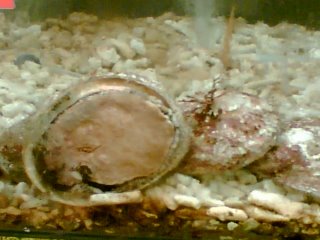
One of the nicest thing - LIVE abalone - RM38.00 per 100 gm. Not sure of the actual species and I am in the midst of researching for my Abalone post. Think it is either the White or Pink Species. BTW, for those who loves to eat this - ITS A SNAIL.......chuckle. Nope, I didnt order this as I dont like abalone.
We were seating around looking at the menu we took ourselves and called a waitress. She came and told us, she only takes Beverage order. Fine. Ordered our beverage, served within 10 minutes. Waited and waited, still no one came and take out order. Stood up, call someone and was ask to wait. You know how long we waited before someone came and took our order. 45 damn minutes and people who came later than us, 5 tables got their order took before us.
I was damn pissed and nearly walked out without paying even for the beverage. MIL was tired and hungry and I have to cool down then. I called a waiter and told him, can someone take our order now ? That poor guy ( not his fault ) called for the SUPV - 2 of them indeed and yet no one came. Then a local dining behind us shouted and the SUPV came. Took our order and then waited for another 30 odd minutes before the dish arrive. *&^$%^$%#%@&#^
Ordered for a Kangkong Belancan, Stir Fried Ostrich with Ginger and Spring Onion, a Seafood Casserole called Seafood Treasure, "Kam Heong " Lala ( clam ) and Chilli Crab.
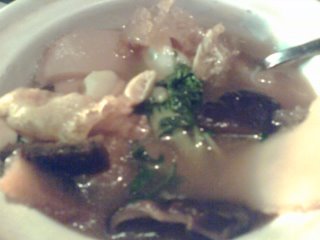
This blur picture is the Seafood Treasure - Sea Sucumber, Fish Maw, Pacific Clam and i cant remember what else. Out of 10, I give them a 4 for flavour.

The Ostrich - 6 /10

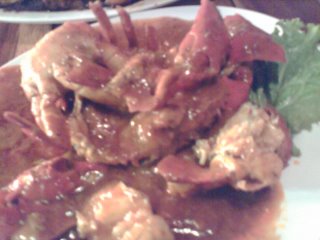
Crab - above taken with mobile phone normal view and bottom with night mode. Out of 10 - err....... 5 max. Diu!

This is the only dish that I think its damn good. The flavour, aroma and taste is near perfect. 8/10
Overall experience - 4/10 fro service rendered, food and ambience. I dont think this restaurant is good - personal view. Compared to Teluk Gong - they are way way behind. I can understand if they are busy as I am also in the same line. 5 order taker ? Man, they are still using the old system of serving. Why cant they sectionized their people like what Teluk Gong is doing. That way, you will ensure all your guests are served promtply and all food arrived ASAP. Imagine serving me a dish from the table behind me and when I pointed out its not mine, the waitress looks at me and told me in Hokkien " Gua Chai" literary means " I know " WTF. If you know, why serve me then ?
Overall pricing is RM97.12
Clam at RM 8.00 - fair price but pricey for Penang.
Crab at RM 25.00 - 1 kg i think
Ostrich at RM 15.00
Kangkong at RM 8.00
Seafood Treasure at RM8.00
Canned Drinks at Rm1.80 per can
Juice - RM2.50
Rice RM1.00 per pax
with 5% Govt Tax and 5% Service Charge
KNS...............I will never never never never never never never never STEP into this restaurant again.
Disclaimer: The opinions expressed here is entirely based on my personal experience and taste. It may vary for others. This review is done solely for personal blog and by no means the reviewer receive any monetary or non monetary compensation.
Called my friend for food place and recommended a place near the Ferry Jetty, i think they are called Tan and Lee Jetty. Wanted to have some seafood ala Penang but Tambun is too far away. Lazy to drive that far for makan since MIL is tired.
We spied a quite new joint in Gurney Drive and I thought it was a tourist makan place. Found out quite a lot of locals dine there too. Guess the food should be ok.
In we went to this place called Bali Hai - picture below

I like the phrase " If it Swims, We Have It" <----- What a bull shit. They do have them but a lot of the seafood are not even "LIVE". I was tempted to ask if they have sea snake ? Kekekeke! Crab dont swim and yet they serve ? Why ?

The entrance to the restaurant. Looks kinda busy, eh ? I was seated on the left side of the entrance underneath a so called hut.

One of the nicest thing - LIVE abalone - RM38.00 per 100 gm. Not sure of the actual species and I am in the midst of researching for my Abalone post. Think it is either the White or Pink Species. BTW, for those who loves to eat this - ITS A SNAIL.......chuckle. Nope, I didnt order this as I dont like abalone.
We were seating around looking at the menu we took ourselves and called a waitress. She came and told us, she only takes Beverage order. Fine. Ordered our beverage, served within 10 minutes. Waited and waited, still no one came and take out order. Stood up, call someone and was ask to wait. You know how long we waited before someone came and took our order. 45 damn minutes and people who came later than us, 5 tables got their order took before us.
I was damn pissed and nearly walked out without paying even for the beverage. MIL was tired and hungry and I have to cool down then. I called a waiter and told him, can someone take our order now ? That poor guy ( not his fault ) called for the SUPV - 2 of them indeed and yet no one came. Then a local dining behind us shouted and the SUPV came. Took our order and then waited for another 30 odd minutes before the dish arrive. *&^$%^$%#%@&#^
Ordered for a Kangkong Belancan, Stir Fried Ostrich with Ginger and Spring Onion, a Seafood Casserole called Seafood Treasure, "Kam Heong " Lala ( clam ) and Chilli Crab.

This blur picture is the Seafood Treasure - Sea Sucumber, Fish Maw, Pacific Clam and i cant remember what else. Out of 10, I give them a 4 for flavour.

The Ostrich - 6 /10


Crab - above taken with mobile phone normal view and bottom with night mode. Out of 10 - err....... 5 max. Diu!

This is the only dish that I think its damn good. The flavour, aroma and taste is near perfect. 8/10
Overall experience - 4/10 fro service rendered, food and ambience. I dont think this restaurant is good - personal view. Compared to Teluk Gong - they are way way behind. I can understand if they are busy as I am also in the same line. 5 order taker ? Man, they are still using the old system of serving. Why cant they sectionized their people like what Teluk Gong is doing. That way, you will ensure all your guests are served promtply and all food arrived ASAP. Imagine serving me a dish from the table behind me and when I pointed out its not mine, the waitress looks at me and told me in Hokkien " Gua Chai" literary means " I know " WTF. If you know, why serve me then ?
Overall pricing is RM97.12
Clam at RM 8.00 - fair price but pricey for Penang.
Crab at RM 25.00 - 1 kg i think
Ostrich at RM 15.00
Kangkong at RM 8.00
Seafood Treasure at RM8.00
Canned Drinks at Rm1.80 per can
Juice - RM2.50
Rice RM1.00 per pax
with 5% Govt Tax and 5% Service Charge
KNS...............I will never never never never never never never never STEP into this restaurant again.
Disclaimer: The opinions expressed here is entirely based on my personal experience and taste. It may vary for others. This review is done solely for personal blog and by no means the reviewer receive any monetary or non monetary compensation.
FooDcrazEE eats at Penang
After Kek Lok Si, we checked in to CIty Bay View Hotel and had to called my friend up here for guidance. He had amzing memory of whole Penang town streets. Told him I was right opposite Campbell Street just before the arch and he can recall every details along the route.
So, I went all to the end of Campbell Street turning left if 'm not mistaken to Carnavon ( not sure of spelling ) and then towards Lebuh Chulia to Leith and then to Farquhar. Am I correct , Penangite ? Cant recall and I dont have a map on hand. Too lazy to search as well.
Checked in, showered, relaxed and say hello to my boss friend's who works there as a F&B Manager. Thanx to him, I got a cheap room.
Decided to go to New Lane off Macalister Road and just before you reach Sunway Hotel for some hawker food as I was told the food there is basically locale. Yummy comes to think of that.
Reach there with a little help from local. Parked my car opposite New Lane.

From opposite New Lane - believe the Kanchil is on Macalister Street, I'm really not sure.
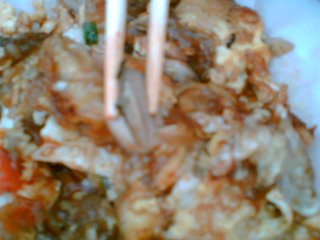
The blur picture of Oh Chien - Fried Oyster Omelette ( so called omelette ) RM6.00 small portion

Forgotten to snap picture and halfway thru eating, snap this. The plate cost me RM4.00, damn cheap. 1 nos of baby octopus at RM1.00, 2 pieces of Loh Bak - Meat Loaf at RM1.00 per piece too and a piece of Her Pneah - Prawn Fritters.
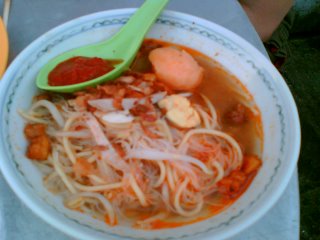
The delicious hokkien mee Penang Style.

Reorder the baby octopus again as I do like it and its dirt cheap

The famous Char Kuay Teow with Duck's Egg. This is local food .
At least I can say, i was not served the tourist thingy...lolz...Oops! Forgotten to took the Laksa's picture but nothing to shout about actually.
Be sure to be here if you visit Penang. Delish food at dirt cheap pricing.
Cheers !
So, I went all to the end of Campbell Street turning left if 'm not mistaken to Carnavon ( not sure of spelling ) and then towards Lebuh Chulia to Leith and then to Farquhar. Am I correct , Penangite ? Cant recall and I dont have a map on hand. Too lazy to search as well.
Checked in, showered, relaxed and say hello to my boss friend's who works there as a F&B Manager. Thanx to him, I got a cheap room.
Decided to go to New Lane off Macalister Road and just before you reach Sunway Hotel for some hawker food as I was told the food there is basically locale. Yummy comes to think of that.
Reach there with a little help from local. Parked my car opposite New Lane.

From opposite New Lane - believe the Kanchil is on Macalister Street, I'm really not sure.

The blur picture of Oh Chien - Fried Oyster Omelette ( so called omelette ) RM6.00 small portion

Forgotten to snap picture and halfway thru eating, snap this. The plate cost me RM4.00, damn cheap. 1 nos of baby octopus at RM1.00, 2 pieces of Loh Bak - Meat Loaf at RM1.00 per piece too and a piece of Her Pneah - Prawn Fritters.

The delicious hokkien mee Penang Style.

Reorder the baby octopus again as I do like it and its dirt cheap

The famous Char Kuay Teow with Duck's Egg. This is local food .
At least I can say, i was not served the tourist thingy...lolz...Oops! Forgotten to took the Laksa's picture but nothing to shout about actually.
Be sure to be here if you visit Penang. Delish food at dirt cheap pricing.
Cheers !
Penang Trip
I have to cancelled my trip to Kelantan due to flood. Phew ! Dont want to get stuck in that....so, off we went to Penang as my MIL wants to revisit Pearl of the Orient after 4 decades. You read right, its 40 years since she last visited Penang. Thats even longer than my life history. Lolz
We set off early at about 7.30 am and of course, I had one of my favourite food in Bentong - Dry Wantan Noodle .

Here's how it looks. Sorry for the blur picture as I am still learning to use my phone camera. Damn, its difficult. This version is so unlike KL or other Malaysian style wantan noodle. Its dry as in KON LOU not flood with the dark and light soy sauce mixture. The best part is the noodle is home made and its really fresh as they spun them only in the early morning. No lye and that is what you want from a noodle.
They are sold out daily and you gotta wait at least 20 - 30 minutes after ordering. The order taker is great...have good memory of what you ordered even with special instruction like no oil, etc.
Reach Penang around noon after few stops here and there for pee break, buying stuffs and just lingering around. It took us near 5 hours to reach Penang from Bentong.
Since my MIL wants to see a lot of tourist attraction, I brought her to Air Itam straight to Kek Lok Si Temple. Yeah Yeah Yeah ! I know what the Penangites will say, No other place meh ? I'm satisfying my MIL's curiosity, k ?
So, I was damn hungry by then and too lazy to locate the so called Best Penang Laksa near the Market. Just went over to a shop at the foothill for my lunch. Yucks and double triple yucky. I was served the Penang Tourist version of Penang food. Look at the blur picture for the so called Penang Hawker Food. It is so shitty that we didnt even finish them.

Penang Char Kuay Teow - the only edible item

The yucky diluted Penang Asam Laksa. Note the stock, didnt even see a sliver of kembong. WTF ! *%#&$^#

Blur close up shot of the mixed up laksa. Where the hell are all the condiments meant to serve the laksa ?
Yucky right ? Ididnt have the pic for the Hock Kien Mee as posted by our famous Penang Mummy Chan Lilian in Penang Faces. I should have read her blog or drop her a call before venturing there. No thanx to Ky of Kyspeaks for not replying my SMS. I sms him for places to makan since he is the only Penang Kia that I knew who blogs about food. Lolz....anyway, some good food I had will be posted later on.
No worry for a lil bad experience.
Cheers !
We set off early at about 7.30 am and of course, I had one of my favourite food in Bentong - Dry Wantan Noodle .

Here's how it looks. Sorry for the blur picture as I am still learning to use my phone camera. Damn, its difficult. This version is so unlike KL or other Malaysian style wantan noodle. Its dry as in KON LOU not flood with the dark and light soy sauce mixture. The best part is the noodle is home made and its really fresh as they spun them only in the early morning. No lye and that is what you want from a noodle.
They are sold out daily and you gotta wait at least 20 - 30 minutes after ordering. The order taker is great...have good memory of what you ordered even with special instruction like no oil, etc.
Reach Penang around noon after few stops here and there for pee break, buying stuffs and just lingering around. It took us near 5 hours to reach Penang from Bentong.
Since my MIL wants to see a lot of tourist attraction, I brought her to Air Itam straight to Kek Lok Si Temple. Yeah Yeah Yeah ! I know what the Penangites will say, No other place meh ? I'm satisfying my MIL's curiosity, k ?
So, I was damn hungry by then and too lazy to locate the so called Best Penang Laksa near the Market. Just went over to a shop at the foothill for my lunch. Yucks and double triple yucky. I was served the Penang Tourist version of Penang food. Look at the blur picture for the so called Penang Hawker Food. It is so shitty that we didnt even finish them.

Penang Char Kuay Teow - the only edible item

The yucky diluted Penang Asam Laksa. Note the stock, didnt even see a sliver of kembong. WTF ! *%#&$^#

Blur close up shot of the mixed up laksa. Where the hell are all the condiments meant to serve the laksa ?
Yucky right ? Ididnt have the pic for the Hock Kien Mee as posted by our famous Penang Mummy Chan Lilian in Penang Faces. I should have read her blog or drop her a call before venturing there. No thanx to Ky of Kyspeaks for not replying my SMS. I sms him for places to makan since he is the only Penang Kia that I knew who blogs about food. Lolz....anyway, some good food I had will be posted later on.
No worry for a lil bad experience.
Cheers !
CNY Chap Goh Meh
I met Pamela last night with her friend Evelyn hope i got the spelling right. Shiryen gave me a call before that. My apologies that I have to meet up some guys down in Ulu Yam for CNY thingy.
Who says you cant light up firecrackers and fireworks.....we did just that and no one came to disturb us.....
Random Picture of the prayers and fireworks around the neighbourhood

The rosted pig ready for chopping up


We hang 9 firecrackers under the tree ...what a racket !


Fire works from around

Joss paper burning


Smokes from the fire crackers - terrible aint it ?





More fireworks !


Laying the table for prayers!

Different angle of the offerings!
How time flies - CNy is OVER !
Cheers !
Who says you cant light up firecrackers and fireworks.....we did just that and no one came to disturb us.....
Random Picture of the prayers and fireworks around the neighbourhood

The rosted pig ready for chopping up


We hang 9 firecrackers under the tree ...what a racket !


Fire works from around

Joss paper burning


Smokes from the fire crackers - terrible aint it ?





More fireworks !


Laying the table for prayers!

Different angle of the offerings!
How time flies - CNy is OVER !
Cheers !
Subscribe to:
Comments (Atom)

